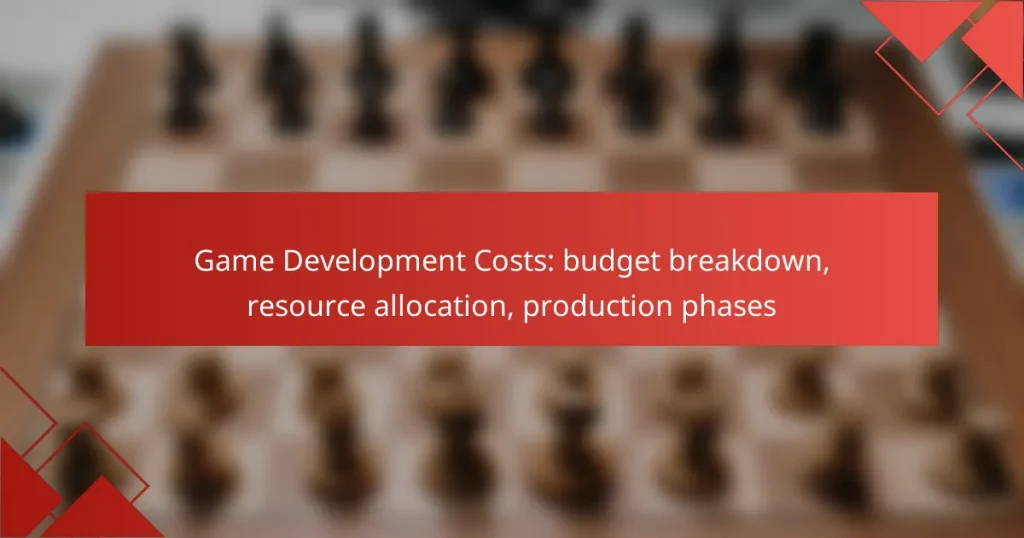Game development costs can vary widely, influenced by factors such as the game’s scale and complexity. Typically, budgets are allocated across three key phases: pre-production, production, and post-production, each with its own financial and resource demands that shape the project’s overall viability.

What are the typical game development costs in the USA?
Game development costs in the USA can vary significantly based on the type of game being produced. Indie games generally have lower budgets, while AAA games can require substantial investment, often reaching millions of dollars.
Average budget range for indie games
The average budget for indie games typically ranges from $10,000 to $500,000. Many indie developers operate on tight budgets, often relying on crowdfunding or personal savings to finance their projects.
Examples of successful indie games include “Stardew Valley” and “Hollow Knight,” which were developed with relatively modest budgets compared to larger titles. This demonstrates that creativity and innovation can often outweigh financial constraints.
Average budget range for AAA games
AAA games usually have budgets that range from $10 million to over $200 million. These projects often involve large teams, extensive marketing campaigns, and high production values, contributing to their significant costs.
For instance, games like “Call of Duty” and “Grand Theft Auto” are known for their massive budgets, which reflect the high expectations for graphics, gameplay, and overall experience in the competitive gaming market.
Factors influencing cost variations
Additionally, the complexity of the game mechanics and the length of the development cycle can significantly impact costs. Games that require extensive testing or unique art styles may also see increased budgets.

How is the budget allocated across game development phases?
The budget for game development is typically divided among three main phases: pre-production, production, and post-production. Each phase has distinct costs and resource requirements that impact the overall financial planning of the project.
Pre-production budget allocation
During pre-production, the budget focuses on concept development, prototyping, and planning. This phase usually accounts for about 10-20% of the total budget, as it involves hiring key personnel, conducting market research, and creating initial designs.
Key expenses include salaries for writers and designers, costs for software tools, and any necessary market analysis. It’s crucial to allocate sufficient funds here to ensure a solid foundation for the game’s development.
Production budget allocation
The production phase typically consumes the largest portion of the budget, often around 60-80%. This phase includes the actual development of the game, encompassing programming, art creation, and sound design.
Costs can vary significantly based on the game’s complexity and team size. For instance, hiring experienced developers and artists can drive up costs, while outsourcing certain tasks may provide savings. It’s essential to monitor spending closely during this phase to avoid budget overruns.
Post-production budget allocation
Post-production usually requires about 10-20% of the total budget and focuses on quality assurance, marketing, and distribution. This phase is critical for polishing the game and ensuring it meets quality standards before launch.
Common expenses include testing, bug fixing, promotional materials, and platform fees for distribution. Allocating enough resources for marketing can significantly impact the game’s success in a competitive market.

What are the key phases of game development?
The key phases of game development include pre-production, production, and post-production. Each phase plays a crucial role in transforming a game concept into a finished product, requiring careful planning, resource allocation, and execution.
Overview of pre-production phase
The pre-production phase is where the foundation of the game is laid. This stage involves brainstorming ideas, defining the game’s concept, and creating a design document that outlines gameplay mechanics, story, and art style.
During pre-production, teams typically establish budgets, timelines, and resource needs. It’s essential to conduct market research to identify target audiences and potential competitors, which can influence design choices and marketing strategies.
Overview of production phase
The production phase is when the actual development of the game takes place. This includes programming, art creation, sound design, and level design, all working towards building a playable version of the game.
Resource allocation is critical during this phase, as teams must balance time and budget constraints. Regular playtesting is recommended to gather feedback and make necessary adjustments. It’s common for production to take several months to years, depending on the game’s complexity.
Overview of post-production phase
The post-production phase focuses on polishing the game and preparing it for release. This includes debugging, optimizing performance, and finalizing marketing materials. Quality assurance testing is vital to ensure a smooth player experience.
After launch, developers may continue to support the game with updates, patches, and downloadable content (DLC). Monitoring player feedback and engagement can guide future improvements and expansions, making post-production an ongoing process rather than a final step.

What resources are essential for game development?
Essential resources for game development include skilled personnel, appropriate technology, and effective marketing strategies. These components work together to ensure a successful game production process from concept to launch.
Human resources needed
Human resources are the backbone of game development, comprising various roles such as game designers, programmers, artists, and sound engineers. Depending on the project’s scale, a small indie team may consist of a few individuals, while larger studios might employ dozens or even hundreds of specialists.
When allocating human resources, consider the balance between creative and technical skills. Hiring freelancers or outsourcing specific tasks can be a cost-effective strategy, especially for smaller budgets.
Technology and tools required
Technology and tools are crucial in game development, including game engines like Unity or Unreal Engine, graphic design software, and project management tools. The choice of technology often depends on the game type and target platforms, such as mobile, PC, or consoles.
Investing in the right tools can significantly enhance productivity and quality. For example, using version control systems can help manage code changes efficiently, while collaboration tools facilitate communication among team members.
Marketing and distribution costs
Marketing and distribution costs are vital for ensuring that a game reaches its intended audience. These expenses can vary widely, from creating promotional materials to running advertising campaigns, often amounting to a significant percentage of the overall budget.
Consider allocating around 20-30% of your total budget for marketing efforts. This includes social media promotions, influencer partnerships, and participation in gaming conventions, which can effectively boost visibility and sales.

What are the common pitfalls in budgeting for game development?
Common pitfalls in budgeting for game development include underestimating production costs, neglecting marketing expenses, and inadequate contingency planning. Recognizing these issues early can help developers allocate resources more effectively and avoid financial shortfalls.
Underestimating production costs
Underestimating production costs is a frequent mistake that can derail a game project. Developers often overlook expenses related to software licenses, hardware, and salaries for skilled personnel, which can add up significantly. For instance, a small indie game might require a budget in the low tens of thousands of USD, while larger projects can easily reach millions.
To avoid this pitfall, create a detailed budget that includes all potential costs, from art and design to programming and testing. Regularly review and adjust this budget as the project evolves to ensure all aspects are covered.
Neglecting marketing expenses
Marketing expenses are often sidelined during budgeting, leading to missed opportunities for game promotion. A solid marketing strategy can require a budget that ranges from 10% to 30% of the total development cost, depending on the target audience and platforms. Without effective marketing, even a well-developed game may struggle to reach its audience.
Include marketing in your initial budget and consider ongoing promotional activities, such as social media campaigns, influencer partnerships, and events. Allocate funds for these efforts to enhance visibility and engagement with potential players.
Inadequate contingency planning
Adequate contingency planning is essential for managing unforeseen challenges during game development. Many projects encounter delays or unexpected costs, which can strain the budget if not anticipated. It is advisable to set aside a contingency fund, typically around 10% to 20% of the total budget, to address these issues without derailing the project.
Regularly assess risks throughout the development process and adjust your contingency plans accordingly. This proactive approach can help mitigate financial stress and keep the project on track, even when surprises arise.

How can developers optimize their game development budget?
Developers can optimize their game development budget by adopting efficient methodologies and exploring alternative funding options. By strategically managing resources and leveraging community support, teams can significantly reduce costs while maintaining quality.
Utilizing agile development methodologies
Agile development methodologies allow teams to work in iterative cycles, enabling flexibility and responsiveness to changes. By breaking the project into smaller, manageable segments, developers can prioritize features based on budget constraints and player feedback.
Implementing agile practices can lead to cost savings by identifying issues early and reducing the need for extensive rework. Regular check-ins and adjustments help ensure that resources are allocated effectively throughout the development process.
Leveraging crowdfunding platforms
Crowdfunding platforms provide an opportunity for developers to raise funds directly from potential players, minimizing financial risk. By presenting a compelling project pitch, developers can attract backers who are interested in supporting innovative game ideas.
Successful campaigns can generate significant funding, often in the low tens of thousands to hundreds of thousands of dollars, depending on the game’s appeal. However, developers should be aware of the time and effort required to maintain backer engagement and fulfill rewards, which can impact overall project timelines.


